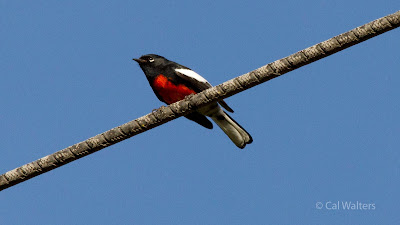Bird doo-doo!
Talk about being late to the party!
Last month, sharp-eyed scientific illustrator Katie Bertsche spotted a Painted Redstart coolin' his (or her?) migratory jets for at least three weeks by all accounts, comfortably hanging out in some trees, and openly for a time on a telephone wire, "actually pretty brave," as described and photographed by Cal Walters on November 17, near College Avenue. Previously, I wouldn't have known a Painted Redstart from a Western Kingbird, much less the ornithological mis-kinship to another bird I've never seen – the American Redstart. (Definitely a mystery to be sorted out later.)
 |
| Painted Redstart (photo courtesy dominic sherony, CC BY-SA 2.0 <https://creativecommons.org/licenses/by-sa/2.0>, via Wikimedia Commons) |
No doubt the little fella is an outlier, a reverse migrator blown-off course during their semi-annual rounds from Arizona to Mexico and Central America and back again. Occasionally, a few stragglers end up in Southern California; only twice have they been spotted in Northern California (Auburn in 2010 and Point Reyes National Seashore in 2012). Amazingly, he (or she?) managed to find hospitable landfall – make that treefall – in Berkeley's arboreally accommodating Elmwood neighborhood. Called a "warbler of surpassing beauty" by The Cornell Lab of Ornithology, he (or she?) is a first-time visitor to Alameda County (so far as we know). Certainly, a first-ever sighting for the area. Naturally, it was a big deal among local and not so local birding enthusiasts who flocked to glimpse the pretty wayward Wood-Warbler.
Last week, on a Lark, hoping to spot the bird in "passerine" I ventured a few miles on my bike southeastward from North Berkeley and did reconnaissance for half an hour, to no avail. My first clue of the bird's absence should have been no sightings of binocular and camera toting bird watchers lurking and skulking about. My second clue should have been, humbling, I'm just a rank amateur. If you weren't there three weeks ago, you probably missed him (or her?), and, safe to say, a once-in-a-lifetime opportunity to lay eyes on a Painted Redstart in Berkeley, California.
Bird gender mystery cleared up: males and females are – gotta love it! – identical. Begetting a further question for heuristic research: how common is this in avian species?


.jpg)

.jpg)
.jpg)





.jpg)

.jpg)


.jpg)





